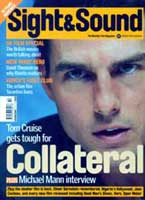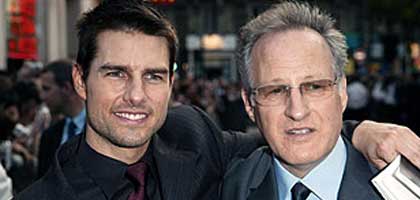
Paint It Black

Mark Olsen talks to Mann about his love of LA, shooting on DV and getting what he wants.
Mark Olsen: In Collateral you seem to be exploring the aesthetics of DV. Was that one of the things that attracted you?
Michael Mann: It's useful here to make an analogy with architecture. When steel was first introduced as a building material architects disguised the structure of their buildings to look like masonry. It wasn't until Louis Sullivan's pioneering work in Chicago in the 1890s that the aesthetics of the steel structure were allowed to be expressed.
So my reason for choosing DV wasn't economy but was to do with the fact that the entire movie takes place in one city, on one night, and you can't see the city at night on motion-picture film the way you can on digital video. And I like the truth-telling feeling I receive when there's very little light on the actors' faces - I think this is the first serious major motion picture done in digital video that is photoreal, rather than using it for effects. DV is also a more painterly medium: you can see what you've done as you shoot because you have the end product sitting in front of you on a Sony high-def monitor, so I could change the contrast to affect the mood, add colour, do all kinds of things you can't do with film. Digital isn't a medium for directors who aren't interested in visualisation, who rely on a set of conventions or aesthetic pre-sets, if you like. But it's perfect for someone like David Fincher or Ridley Scott - directors who previsualise and know just what they want to achieve.
MO: Did digital allow you to use a smaller crew or make the production more mobile?
MM: Not the way we did it. We had a whole film complement working alongside us so we could shoot in either medium. If we could shoot on film, we did, though in the end 80 per cent of the movie was shot on video. For instance, the shootout in the Korean disco was done on film because we were on a big interior set that had to be lit and we could move around more freely with the camera on our shoulder shooting 35mm than we could using digital.
I find that I'm a convert to multi-media. On my next film there'll be some scenes shot on film - there's no reason not to use film for a daylight desert scene, for instance, though if I went digital I wouldn't use the Sony camera but perhaps the Viper since the Thomson chip responds especially well to a lot of light and has fabulous warm colours.
MO: What about the shot towards the end of 'Collateral' when James Foxx is on top of the parking garage looking up at the windows of an office building where Jada Pinkett Smith is on one floor and Tom Cruise on another?
MM: That's a perfect example of why I shot this picture in high-def, of the best of what digital can achieve. There are a couple of lights on the parking structure that were just there, but I don't think we added any light to the scene.
MO: 'Collateral' traces a very real geography of Los Angeles, which is something you also explored in 'Heat'.
MM: It isn't always topographically accurate - for instance, when they head towards the El Rodeo nightclub I detour them through Wilmington. Selecting the location always had to do with the content of the scene and this was the first time they got familiar and personal with each other so I wanted the most impersonal and depopulated landscape I could imagine. I always look for anomalies, and the idea of a club like El Rodeo in the middle of the oil refineries in that area around San Pedro and Wilmington is bizarre. But there are clubs like that, all kinds of weird nightlife in the middle of this forest of fragmenting columns.
I always try to find something that makes a scene feel real, and what makes things feel true to me is usually something anomalous, a component you would never expect to find, so it doesn't look manicured or perfect. This can be a location, a gesture, an expression, a thought in somebody's head - if you look at life, that's what it's like.
MO: You made a lot of changes to the script, most notably moving it from New York to Los Angeles. What attracted you to the concept in the first place?
MM: Los Angeles is relatively undiscovered as a location for pictures. It has its own pattern of culture which is almost like travelling on the internet - when you visit websites you journey through some kind of interstitial space and the domains are not contiguous. I think LA is the most exciting contemporary city in the United States, but you have to know where to go. And a lot of Angelinos don't.
In terms of the script, the most important part of it for me was the structure, which was brilliant. I did a lot of re-writing but I didn't change anything significant, which is why Stuart Beattie has sole screenplay credit. We changed the culture, the locale, the characters' back stories and what they talk about, but I didn't change the narrative structure or the engineering under the surface, which is the really difficult thing to do well in a script.
I'd asked myself what I wanted to do next before I even came across Collateral and I'd decided I wanted to do a very condensed narrative, one in which you'd take what would normally be the third act of a three-act structure and make it into the whole motion picture. I was interested in an intense character piece, with characters in collision within a compressed narrative frame, in contrast with the elaborate but un-intense experience of dealing with the actual events of Muhammad Ali's life from 1964 to 1974 in five cities on two continents, which was an epic narrative involving a whole different set of dynamics. There were two screenplays that came to my attention and Collateral was the better of the two. I was drawn to the feel of a lifeboat making a night-time odyssey through the city.
